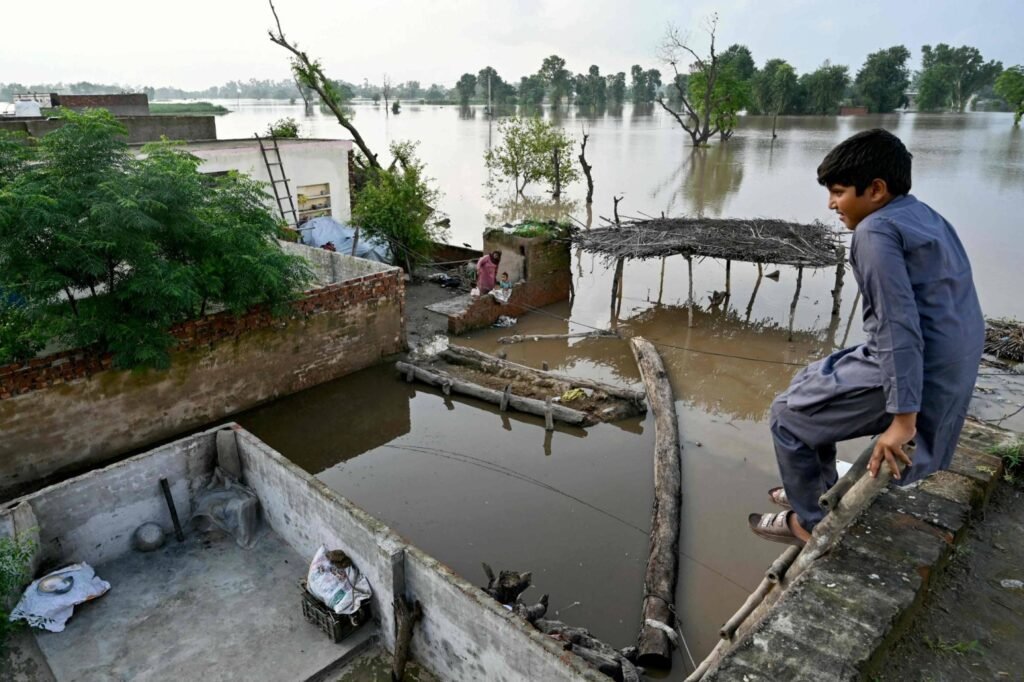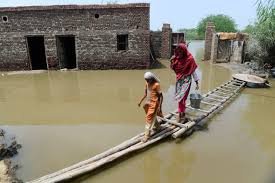
Pakistan remains acutely vulnerable to climate-induced disasters, particularly monsoon floods. The country has witnessed repeated large-scale inundations — 2010, 2022, and now 2025 — each displacing millions, damaging infrastructure, and exposing governance gaps.
The 2022 floods alone affected over 14 million people, destroyed 2 million homes, and damaged 20,000 schools, making it one of the worst disasters in recent history.
Despite lessons from past disasters, illegal encroachments, weak governance, and underinvestment in flood management continue to exacerbate risks. Barrages such as Guddu and Sukkur, designed to handle up to 1 million cusecs, have so far held, but they remain under constant stress during peak monsoon flows.
The key future challenge is clear: unless natural waterways are restored and encroachments removed, every monsoon season will continue to bring large-scale humanitarian crises.
Province-Wise Situation and Challenges
Punjab
Heavy rains and upstream flows from India (Himachal Pradesh, Jammu & Kashmir, Punjab) have pushed combined flows of Chenab and Sutlej to over 600,000 cusecs at Punjnad.
Punjab has an advantage in terms of its topography. This province has a relatively steep gradient; e.g., Sialkot (256m above sea level) down to Rahim Yar Khan (83m) — a drop of 173m. This allows faster natural drainage compared to Sindh.
Challenges Ahead:
• Increasing inflows from India during extreme rainfall events.
• Stress on barrages during multi-day sustained flows.
• Urban flooding in cities due to poor drainage infrastructure.
Sindh
Sindh is currently facing a continuing flood wave moving downstream from Punjab. Guddu Barrage has already seen flows exceeding 500,000 cusecs, with expectations of 700,000 cusecs sustained for 7–10 days.
Unlike Punjab, Sindh has its limitations as regards its topography. It has a flat gradient — Ghotki (north Sindh) to Shahbandar (delta) drops only 32m — traps water for extended periods. This was evident in 2022, when floodwaters stagnated for months.
Large-scale illegal settlements, private bunds, and agricultural land grabs in riverine (katcha) areas obstruct natural drainage. Despite court orders (2020, 2021, 2023) and Flood Inquiry Commission (2022) recommendations, the government has failed to remove them.
Challenges Ahead:
• Sustained flood risk every monsoon due to blocked natural waterways.
• Weak governance and lack of enforcement.
• Need for massive investment in restoring drainage networks (estimated $357.5m for natural channels, $253.1m for floodwater disposal).
• Long-term threat to agriculture, infrastructure, and livelihoods if stagnation continues.
Khyber Pakhtunkhwa (KP)

In August 2025, Buner, Shangla, and Swat saw devastating flash floods and hill torrents, killing over 300 people. Earlier, in Gilgit and Hunza, glacier melt and intense rains triggered landslides, mudflows, and flash floods, trapping hundreds of tourists.
Mountainous terrain amplifies the destructive power of flash floods and glacial lake outbursts. Settlements along riverbanks and valley floors are highly vulnerable.
Challenges Ahead:
• Growing risk of glacial lake outburst floods (GLOFs) due to accelerated glacier melting.
• Weak early warning and evacuation systems in remote valleys.
• Need for climate-resilient infrastructure (roads, bridges, housing).
Balochistan
Balochistan often suffers from flash floods due to its arid terrain and poor drainage capacity. In past floods (2022), its remote districts faced severe isolation and prolonged humanitarian crises.
Challenges Ahead:
• Poor connectivity delays rescue and relief.
• Limited embankment or flood protection structures.
• Water retention vs. flood control dilemma in a drought-prone province.
• Key Future Challenges for Pakistan
Climate Change: Intensifying monsoon rains, glacial melt, and erratic weather patterns will make floods more frequent and destructive.
Encroachments: Illegal structures in riverine areas and blocked natural waterways threaten the effectiveness of flood protection infrastructure.
Governance Gaps: Despite court orders and commission reports, enforcement remains weak, reflecting lack of political will.
Infrastructure Strain: While barrages have held so far, prolonged high flows could test their limits.
Stagnant Waters in Sindh: With minimal slope and blocked channels, Sindh faces months-long waterlogging, causing agricultural, health, and livelihood crises.
Financial Burden: The cost of flood damages far exceeds the cost of preventive infrastructure, yet investments remain delayed.
Pakistan’s flood risk is not just a natural hazard but a governance and planning crisis. The north (KP & Gilgit-Baltistan) faces flash floods and glacier-related risks; Punjab confronts rising upstream inflows but benefits from natural drainage; Sindh remains the most exposed due to flat terrain and blocked natural waterways; and Balochistan suffers from isolation and inadequate infrastructure.
Unless systemic reforms, strict enforcement against encroachments, and investments in natural drainage restoration are prioritized, Pakistan will continue to face catastrophic floods every monsoon — with mounting human, economic, and ecological costs. – ER News Desk (Reported ER Sep.16-30, 2025)
